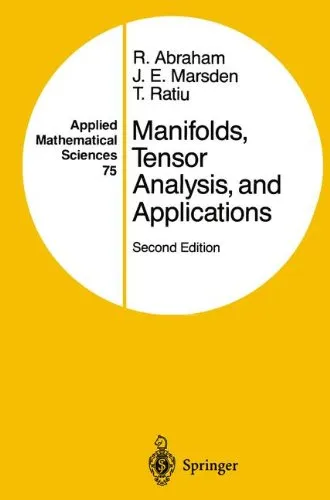Manifolds, Tensor Analysis, and Applications (2007 version)
4.9
Reviews from our users

You Can Ask your questions from this book's AI after Login
Each download or ask from book AI costs 2 points. To earn more free points, please visit the Points Guide Page and complete some valuable actions.Introduction to "Manifolds, Tensor Analysis, and Applications (2007 version)"
Written by Jerrold E. Marsden and Tudor Ratiu, with the collaboration of Ralph Abraham, the book "Manifolds, Tensor Analysis, and Applications" stands as a defining text in the fields of differential geometry, advanced mathematics, and their applications to physics and engineering. First published as part of the distinguished Applied Mathematical Sciences series, this 2007 edition brings a rigorous, yet approachable perspective to the study of manifolds, tensor fields, and their functional roles in applied settings. With nearly four decades of influence, this book remains a cornerstone reference for students and professionals alike.
Detailed Summary of the Book
"Manifolds, Tensor Analysis, and Applications" is structured as a comprehensive guide for readers seeking a deep understanding of the topics at the intersection of geometry, topology, and algebra. The book begins with foundational ideas in manifolds, such as coordinate systems, tangent spaces, and vector fields. The authors meticulously bridge theory and application, gradually introducing critical ideas like differential forms, Lie derivatives, and integration on manifolds.
Tensor analysis serves as a unifying thread in the text, connecting abstract geometric principles to their physical counterparts, such as deformation mechanics, electromagnetism, and fluid dynamics. Applications are woven throughout the chapters, ensuring relevance for scientists and engineers working on complex systems. These include carefully crafted examples ranging from mechanical systems governed by Lagrangian dynamics to Hamiltonian structures encountered in modern physics.
The book achieves depth without sacrificing clarity, thanks to its organized progression and carefully chosen examples. For advanced readers, the later chapters explore advanced topics, such as Riemannian metrics, symplectic geometry, and the fundamentals of Lie group theory. The text concludes with an exposition on global analysis and fields on compact manifolds, providing a peek into the rich interactions between geometry and topology.
Key Takeaways
- Comprehensive introduction to manifolds and tensor analysis for both mathematicians and practitioners in allied fields.
- Explicit treatment of differential forms, Lie groups, differential topology, and their diverse applications.
- A balance between rigorous mathematical theory and practical applications in physics and engineering.
- Engaging examples that illustrate complex ideas in tangible real-world contexts.
- Profound insights into global analysis, including Stokes' Theorem and its geometric implications.
By the end of the book, readers will have a profound understanding of the geometric language underlying modern mathematical physics as well as deep insights into how to build bridges between abstract theory and practical problem-solving.
Famous Quotes from the Book
"Geometric intuition is as important to mathematicians as physical intuition is to physicists."
"Manifolds are the stage upon which the equations of physics and nature perform their symphony."
Such iconic lines from the authors underscore the core essence of their work: guiding readers to unite mathematical beauty with physical understanding.
Why This Book Matters
In a world increasingly reliant on advanced math and physics to address scientific and engineering challenges, "Manifolds, Tensor Analysis, and Applications" remains uniquely indispensable. Its emphasis on combining rigor with practicality equips readers to tackle contemporary problems in areas like robotics, aerodynamics, astrodynamics, and control theory. Its systematic approach empowers graduate students, educators, and researchers alike.
The enduring relevance of this text comes from its dual ability to clarify abstract mathematics and ignite an appreciation for its elegance. By presenting manifolds, tensors, and their uses in applied contexts, Marsden, Ratiu, and Abraham have gifted the academic community a text that is not merely theoretical but transformative. It continues to shape disciplines, inspire innovations, and enrich mathematical education across the globe.
Free Direct Download
Get Free Access to Download this and other Thousands of Books (Join Now)
For read this book you need PDF Reader Software like Foxit Reader
Accessing books through legal platforms and public libraries not only supports the rights of authors and publishers but also contributes to the sustainability of reading culture. Before downloading, please take a moment to consider these options.
Find this book on other platforms:
WorldCat helps you find books in libraries worldwide.
See ratings, reviews, and discussions on Goodreads.
Find and buy rare or used books on AbeBooks.


